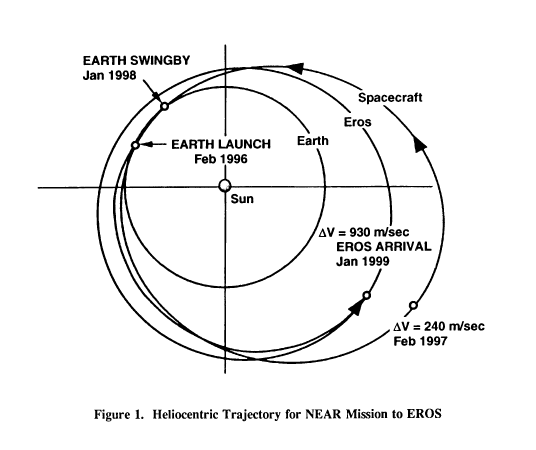
Douglas Isbell
Headquarters, Washington, D.C.
September 21, 1994
(Phone: 202/358-1753)
RELEASE: 94-159
NASA NAMES SCIENCE TEAM FOR ASTEROID RENDEZVOUS MISSION
NASA has selected the science team for the first spacecraft
designed to rendezvous with an asteroid.
The Near Earth Asteroid Rendezvous (NEAR) mission promises
to answer fundamental questions about the nature of near-Earth
objects such as asteroids and comets. These objects are
believed to consist of debris from the earliest days of
planetary formation 4.5 billion years ago, so better knowledge
of them should provide clues about the origin and evolution of
the Solar System.
Scheduled for launch in February 1996 aboard a Delta 2
rocket, the NEAR spacecraft should arrive in orbit around
asteroid 433 Eros in early January 1999. It will then survey
the rocky body for a minimum of one year, at altitudes as
close as 15 miles (24 kilometers). Eros is one of the largest
and best-observed asteroids whose orbits cross Earth's path.
These asteroids are closely related to the more numerous "Main
Belt" asteroids that orbit the Sun in a vast doughnut-shaped
ring between Mars and Jupiter.
The goal of the NEAR project is to carry out a mission with
high scientific return and wide participation at relatively
modest cost. It will seek the first comprehensive
measurements of an asteroid's mass, structure, geology,
mineral composition, and gravity and magnetic fields. Science
data and related products will be archived in near real-time
in NASA's Planetary Data System (PDS), with access for the
general science community, the public and educators via the
Internet.
The NEAR Science Payload consists of six instruments: a
multispectral imager system; a near-infrared spectrograph; an
X-ray/gamma-ray spectrometer; a magnetometer; a laser
altimeter; and the spacecraft's radio, which is also used for
gravity measurements.
The members of the NEAR science team are:
Multispectral Imager/Near-Infrared Spectrograph
Joseph Veverka, Cornell University (Team Leader), Ithaca, N.Y.
James F. Bell III, NASA Ames Research Center, Mountain View, Calif.
Clark R. Chapman, Planetary Science Institute, Tucson, Ariz.
Michael C. Malin, Malin Space Science Systems, Inc., San Diego, Calif.
Lucy-Ann A. McFadden, University of Maryland, College Park,Md.
Mark S. Robinson, U.S. Geological Survey, Flagstaff, Ariz.
Peter C. Thomas, Cornell University
X-ray/Gamma-Ray Spectrometer
Jacob I. Trombka, NASA Goddard Space Flight Center (TeamLeader), Greenbelt, Md.
William V. Boynton, University of Arizona, Tucson
Johannes Bruckner, Max Planck Institut fur Chemie, Mainz, Germany
Steven W. Squyres, Cornell University
Magnetometer
Mario H. Acuna, Goddard Space Flight Center (Team Leader)
Christopher T. Russell, University of California, Los Angeles
Light Imaging Detector and Ranger (LIDAR)
Maria T. Zuber, Goddard Space Flight Center (Team Leader)
Radio Science
Donald K. Yeomans, NASA Jet Propulsion Laboratory (Team Leader), Pasadena, Calif.
Jean-Pierre Barriot, Centre National D'Etudes Spatiales, Toulouse, France
Alexander S. Konopoliv, Jet Propulsion Laboratory
The NEAR Project Science Group will be co-chaired by Dr. Jurgen Rahe,
the NASA Headquarters Program Scientist, and Dr. Andrew F. Cheng, NEAR
Project Scientist at the Johns Hopkins University Applied Physics
Laboratory (APL) in Laurel, Md. APL will build and operate NEAR, making it the
first NASA planetary mission to be conducted by a non-NASA space center.
The facility-class Instrument Scientists at APL will be the
main interface between the science team leaders and project engineers. The
Instrument Scientists are:
- Scott L. Murchie (Multispectral Imager/Near-Infrared Spectrograph)
- Ralph L. McNutt (X-ray/Gamma-Ray Spectrometer)
- Larry J. Zanetti (Magnetometer)
- Andrew F. Cheng (LIDAR)
The NEAR project began in late 1993. NEAR will be the
first launch in NASA's Discovery program, an initiative based
on small planetary science missions with short development
cycles and stringent cost caps. It requires missions to
proceed from development to flight in less than three years,
with total spacecraft and instrument development costs limited
to no more than $150 million (in FY 1992 dollars) and an
acceptance of a greater level of technical risk than on
typical NASA missions.
The Solar System Exploration Division of the Office of
Space Science at NASA Headquarters has program management
responsibility for the NEAR mission.
 NEAR Trajectory
NEAR Trajectory
 Return to MSSS Home Page
Return to MSSS Home Page